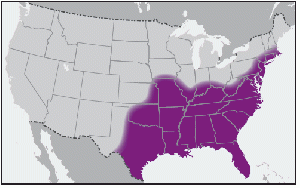Ehrlichiosis
Background
- Bacterial infection of the family Anaplasmataceae common in mammals such as cattle, dogs, sheep, goats, and horses[1]
- Spread by the Lonestar tick (Amblyomma americanum)
- Eastern seaboard from Florida to Maine and as far west as Iowa and Texas
- States with the highest incidence:[2]
- Rhode Island (36.5 cases per million)
- Minnesota (3.9 to 12.3 cases per million)
- Connecticut (8.1 to 15.9 cases per million)
- People often unaware they are bitten with case fatality rate of approximately 1.8%[3]
- More severe disease in immunocompromised patients (HIV, Elderly, Asplenic)
Clinical Features
- Variable spectrum of severity of disease
- Fever/chills (abrupt onset), malaise, myalgias
- Headache
- Nausea/vomiting, diarrhea
- Conjunctival injection
- Rash
- Up to 60% in children, 30% of adults
Differential Diagnosis
Tick Borne Illnesses
- Babesiosis
- Colorado tick fever
- Ehrlichiosis
- Heartland virus
- Lyme
- Murine typhus
- Rocky mountain spotted fever
- Southern tick-associated rash illness (STARI)
- Tick paralysis
- Tularemia
Evaluation
- Peripheral blood smear[4]
- Obligate intracellular organism
- Smear shows intracellular parasites only 20% of time
- PCR
- Most sensitive in first week of illness
- Indirect Immunoflorescence Assay'
- Gold Standard
- Negative 85% of time in first 7 days of illness
- Compare 2 samples drawn at different times
- 4 fold increase in titers of second draw is positive
- Enzyme Immunoassay
- Qualitative tests, not quantitative
- Leukopenia, thrombocytopenia, and transaminitis often present
Management
Antibiotics should be continued for 5 days after the last recorded fever.
- Adults: Doxycycline 100mg PO/IV BID x 14 days
- Pediatrics: under 45 kg use Doxycycline 2.2mg/kg PO/IV twice a day
- Pregnant: Rifampin 300mg PO every 12 hours
Disposition
- Most cases are treated as an outpatient
See also
References
- ↑ CDC. Ehrlichiosis. http://www.cdc.gov/ehrlichiosis.
- ↑ Sexton DJ and McClain MT. Human ehrlichiosis and anaplasmosis. UpToDate.
- ↑ CDC http://www.cdc.gov/ehrlichiosis/stats/
- ↑ http://www.cdc.gov/ehrlichiosis/symptoms/index.html#diagnosis





